Registan Square with its Madras and legend. Samarkand, Uzbekistan
Registan Square with its Madras and legend. Samarkand, Uzbekistan
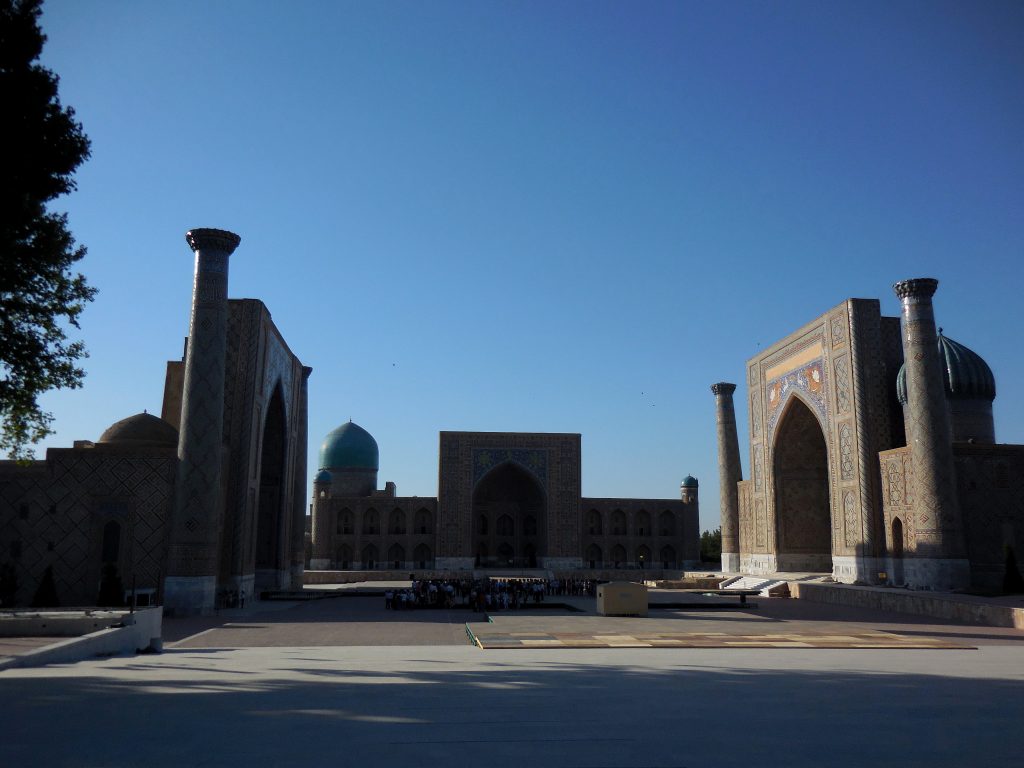
Ancient city center, Registon square (“the sandy place”) was the space of commercial exchanges well before the Mongol invasion. From the 14th century, it is the official center of Samarkand, from which six main streets radiate on the junction where is placed a large dome; built by Tuman-aka, wife of Tamerlane.
Under Ulugbek, (1409-1449), the square is no longer the seat of the Bazaar, but a place of official ceremonies and political, cultural center of the city. Along the perimeter, buildings are therefore a symbol of power: the great Madras on the western side (1417-1420), the Caravanserai (a shelter for caravans) on the northern side and the high Sufi Kharnaka (monastery for the dervishes) on the eastern one.
In the 17th century, under Yalangtush Bahadur, the square is again transformed: the Ulugbek Madras undergoes serious changes, the Madras Sher-Dor (1619-1636) is built, instead of the Caravanserai and the Tillya-Kari Madras is erected (1646- 1660). The square now presents the three Madras that today’s travelers can admire in their majesty as soon as they reach the place.
Ulugbek Madras
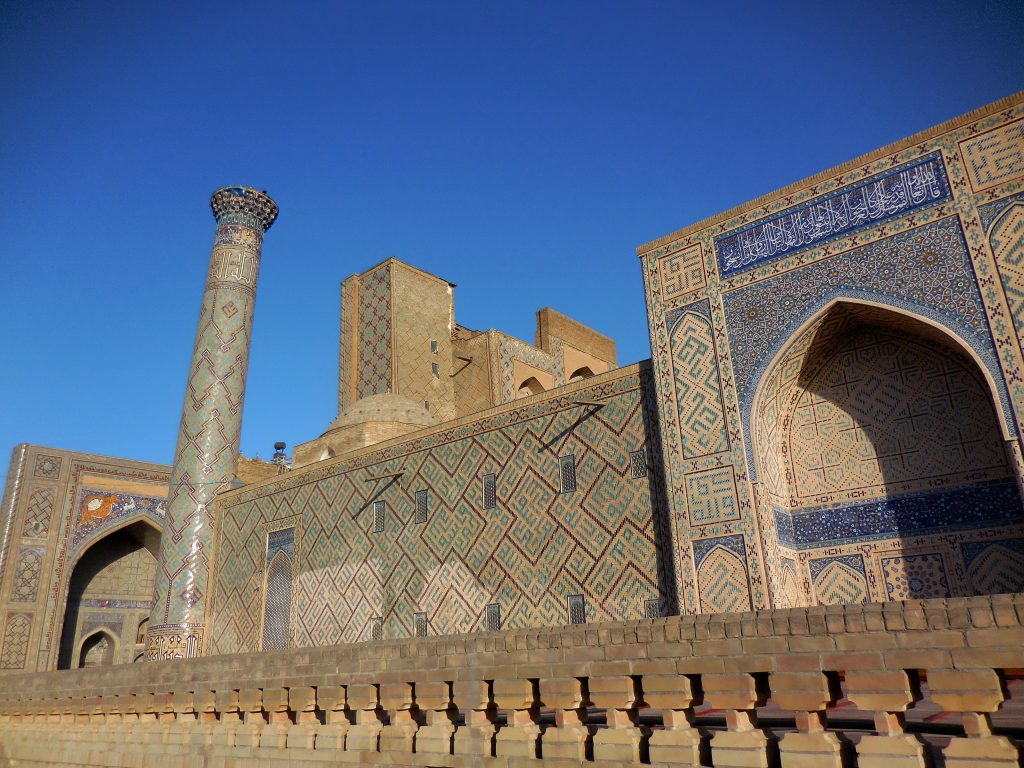
The major religious institution of Samarcank of the 15th century, the Madras is the only University of this period. Originally, the building is divided into more than 50 cells, where students live and study Theology, Mathematics, Astronomy, Philosophy. Among themost eminent Central Asian scholars and scientists teach there are: Kazi-Zadeh Rumi, Ghiyasaddin Jemshid, Ali Kunshchi … Abdurakhman Djami, an important Tajik poet, philosopher and scientist, completes his studies in this Madras. Also the ruler Ulugbek from some Mathematics lessons, like other nobles of the court.
Original construction project is named after Kavamaddin Sherazi, father of Ulugbek himself. The dimensions of the Madras are 81 x 51 m., with an internal courtyard of 30 x 30 m., dimensions comparable with the architectural structures of Tamerlane. On the main facade, from the portal depart the walls that end in high minarets. Spiral-shaped decorations accentuate the symmetry of the shapes and push the observer’s eye upwards.

Inside, under the dome start two-tier rows of cells where the lessons were held. On the marble facades are carved magnificent mosaics and majolica with geometric, floral and epigraphic motifs. The panel on the entrance arch is distinguished by its representation of the starry vault.
In the 20th century, the Madras is restored several times; the major works take place between 1930 and 1990.
Legends on the Ulugbek Madras
When the construction of the Madras was at an end, Ulugbek was looking for the future Rector of the University, a competent figure in all the sciences. His words were heard by Maulana Mohammed Havafi, sitting in dirty clothes on a pile of rock. Ulugbek began to ask him questions, which, with his surprise, Havafi answered in a comprehensive manner. Satisfied with the interview, Ulugbek ordered Havafi to be taken to the Hall of the Baths, washed and dressed appropriately. At the opening, the first lesson of the ex-tramp was so complicated that none of the 90 scientists understood the material treated, apart, of course, Ulugbek and his teacher Kazi-Zadeh Rumi.
Sher-Dor Madras

The Khan of Bokharan, Yalangtush Bahadur, has built a new Madras in 1619 instead of the decaying Ulugbek khanaka; the dimensions of the façade are similar to those of the Ulugbek Madras, in terms of shape and height. The gigantic ogival portal and the high minarets on the sides are symmetrical with respect to the oldest Madras, however the foundations of Sher-Dor are more than 1.5 m tall. The building is 70 x 56 meters, with an internal courtyard of 30 x 38 meters.
Inside, a double order of cells (hujras) where the students were living and six classes (ayvans and darskhanas) runs through the walls of the building. The minarets are placed on the front side, while on the opposite sides there are two massive towers. Peculiar decorations are above the entrance arch, where there is the heraldic symbol of the khanate: two tigers chase a baby deer. On the back of the fairs two new anthropomorphic suns are designed. This emblem gives the name to the Madras: Sher-Dor means “having tigers”.
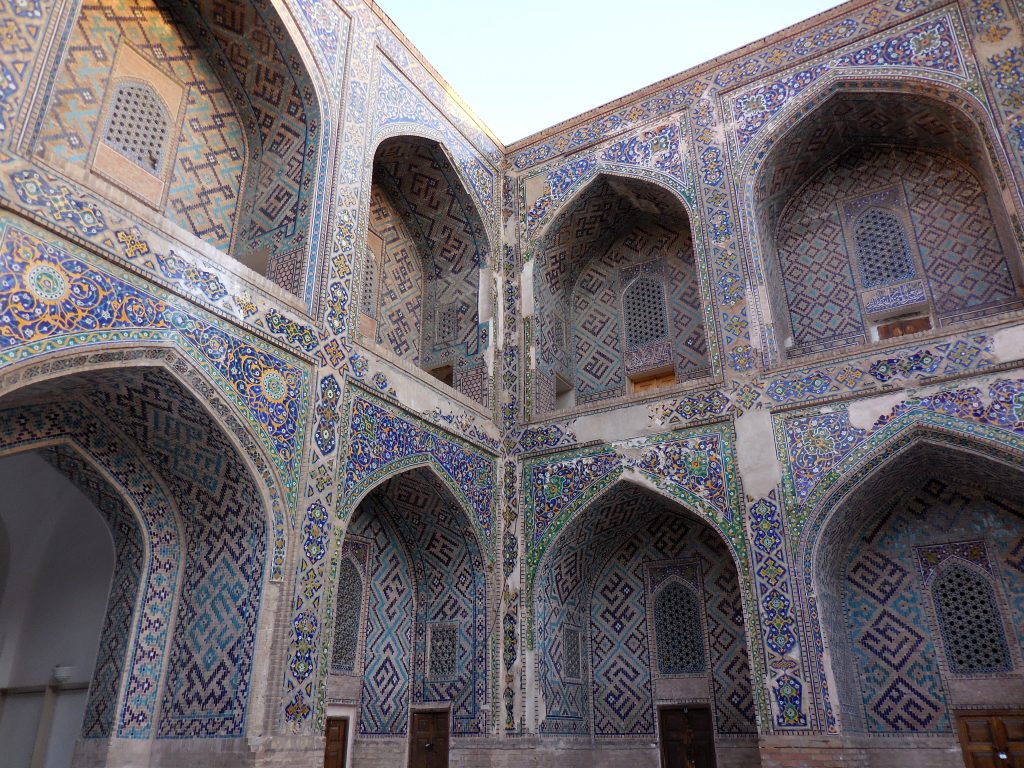
The outer surface is extensively decorated with enamelled bricks, intricate mosaics and gilded motifs. The inner walls of the courtyard have floral motifs and golden gems, which form a complicated ornamental motif. The phyto-morphic figures, together with the floral vases, depict the tree of life, a symbol present in the Islamic decorative tradition.
Tillya-Kari Madras
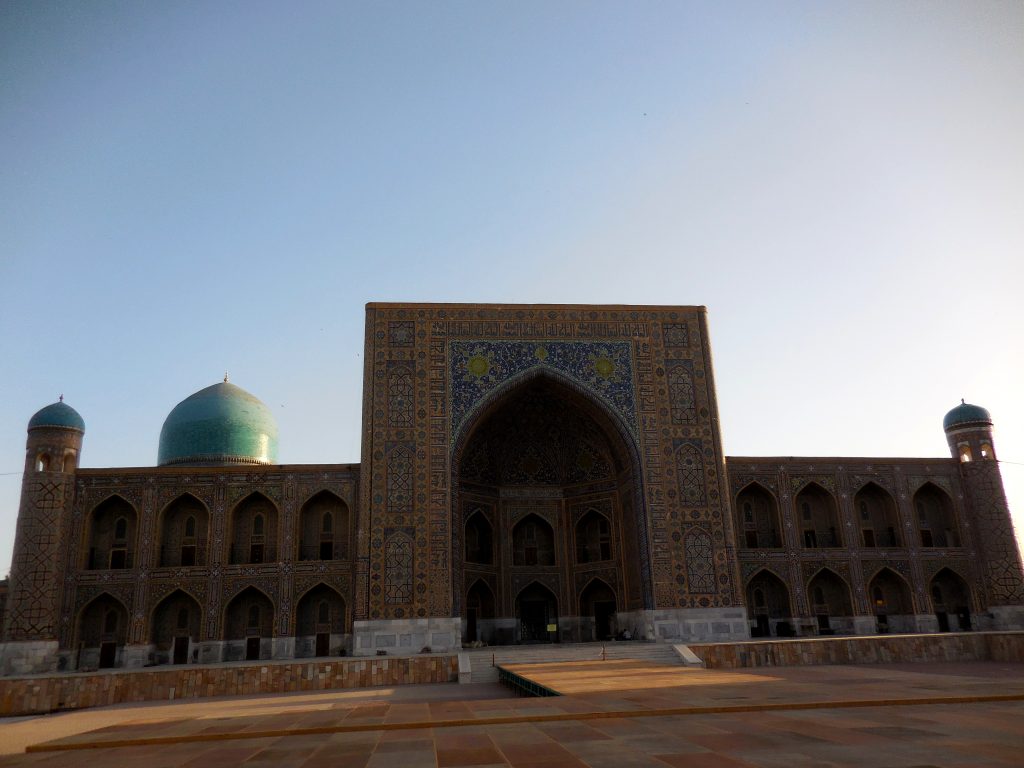
In 1646, ten years after Sher-Dor was completed, Khan Bahadur ordered the construction of a new building, a combination of Madras and Juma-Mosque. The new building stands on the North side of the square, among the existing structures; the architect appointed thus seeks an architectural balance with the other two Madras. Tillya-Kari has a longer length in order to create a more collected view of space; in the quest to be a worthy background to the most important square of Samarkand.
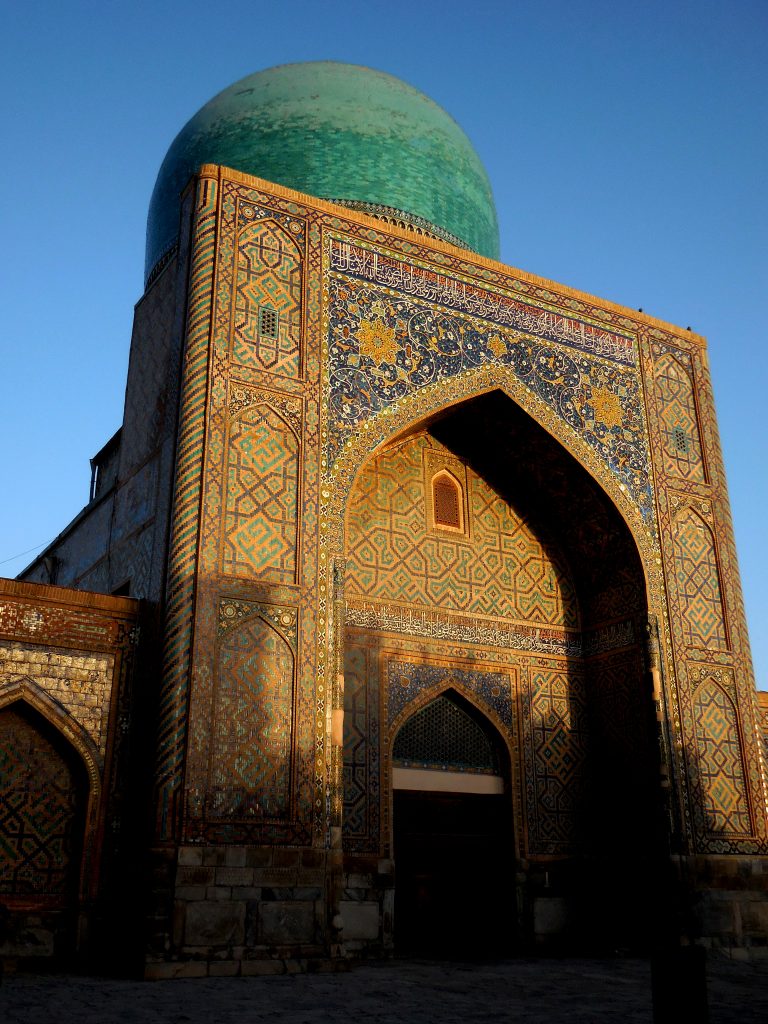
Inside, the cells are placed on a floor and surround the four classes of the Madras. In the western part, the Mosque with adjacent galleries is located under a dome. The beauty of the building is found in the golden kundal style decorations. In the place of worship, the mihrab (the niche showing the direction to Mecca) and the minbar (the tribune of the imam) are rich in golden figures and light muqarnas. The central room has concentric decorations and muqarnas that raise the space to amaze the viewer with their refinement and richness. These sumptuous decorations give the name to the Madras, Tillya-Kari, which means “covered with gold”.
The remaining facades of the monument are covered with enamelled bricks, majolica with geometric patterns and phyto-forms. The huge wooden door of the facade decorated with epigraphic and floral elements.
Advice for the visit
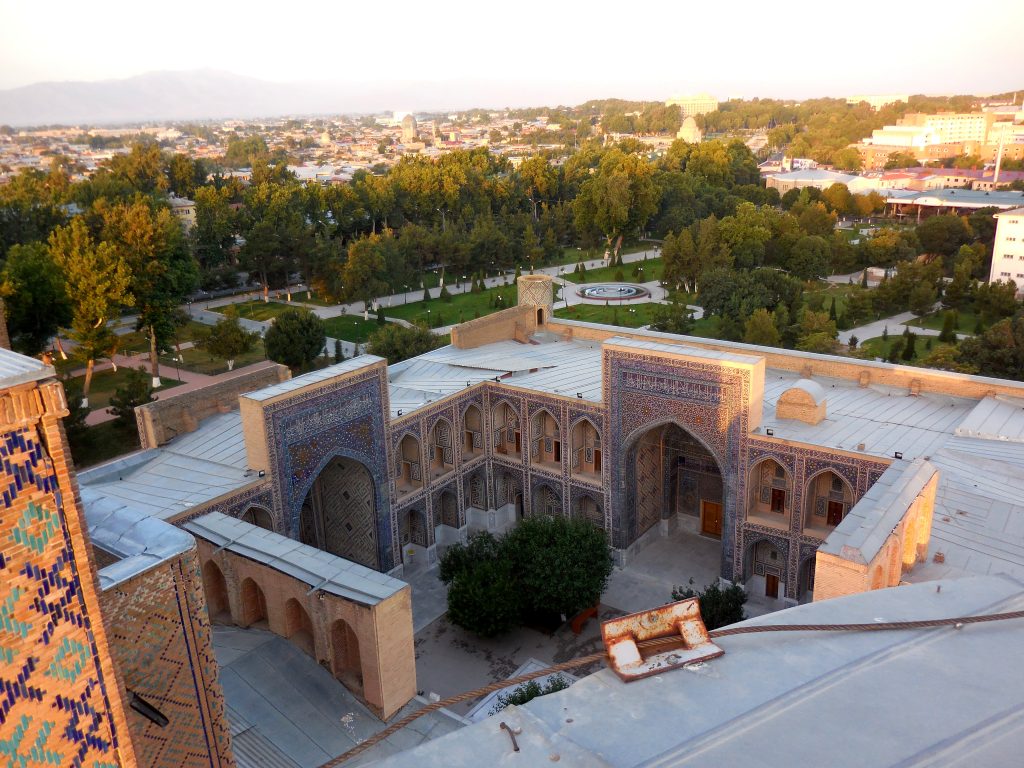
I went to Samarkand in early June; in that period Registan Square can be visited by the public only from 11.00 to 15.00 in the afternoon; when the sun beats the most. Asking one of the guards for advice, he suggested me to visit the inside of the Madras at 5.00 in the morning. I’m not an early riser, but the idea of visiting the square during the hottest hours certainly did not attract me.
So, on time, I arrived at 5.00 am at the bars where the soldiers let me in and I must say that I enjoyed the square in full solitude, savoring every possible landscape and trying to live the ancient atmosphere of the place. The soldiers, with a small tip of about two euros, let me get on the Minaret of the Ulugbek Madras, closed to the public. The tortuous steps led me to the top of the monument, from which the newly wakened Samarcank greeted me in rosy hue in the cool breeze. From the minaret I have also been able to access the cells on the second floor, appreciating an unusual point of view.
In addition to visiting the Square, the early riser allowed me to experience the city at the first light of dawn, when the Uzbeks, a working people, were already struggling with the first chores; like street cleaning or market preparation not far away. The only thing I missed was a good Café in the area where I could drink my first chai.
For information on Bibi-Khanum Mosque, click here.
See address here.
Source: A.V. Samarkand, the city and the legends, Davr Nashriyoti, Tashkent, 2014
Photo by Eva Zalesakova

Pingback: Samarkand the Great; History and tips. Uzbekistan, Central Asia | Central Asia
Pingback: The architectural complex Shah-i-Zindah in Samarkand. Uzbekistan | Erica Leoni